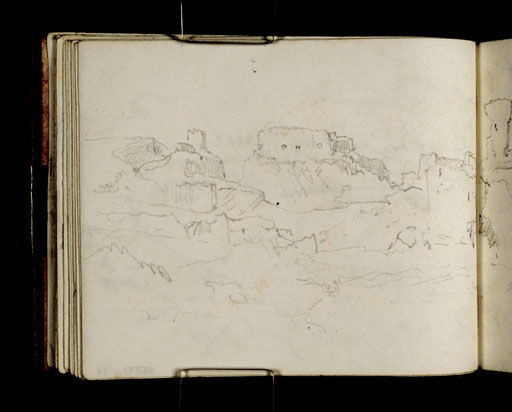Joseph Mallord William Turner Dunbar 1818
Image 1 of 2
Joseph Mallord William Turner,
Dunbar
1818
Joseph Mallord William Turner 1775–1851
Folio 24 Verso:
Dunbar 1818
D13496
Turner Bequest CLXVI 24a
Turner Bequest CLXVI 24a
Pencil on white wove paper, 90 x 112 mm
Accepted by the nation as part of the Turner Bequest 1856
References
1909
A.J. Finberg, A Complete Inventory of the Drawings of the Turner Bequest, London 1909, vol.I, p.482, CLXVI 24a, as ‘Dunbar.’.
As Finberg has pointed out, the drawing across this and the following page (folio 25; D13497) is one of three compositions that Turner based his watercolour of Dunbar, circa 1823 (private collection)1 upon;2 the other two being in the Scotch Antiquities sketchbook (Tate D13633–D13634, D13639–D13640; Turner Bequest CLXVII 29a–30, 31c–32).
The present drawing, with its squarer format that is closer to the relative dimensions of the final design, provides the compositional layout of the watercolour, and many of the details and the shading are also translated into this design. However, the shape of the ruins are derived more directly from the two Scotch Antiquities sketches and the tiny figures in the illustration are developed from the first sketch in that book.
Turner’s Provincial Antiquities illustrations typically drew upon a number of studies from the three Scottish sketchbooks. Bass Rock, circa 1824 (watercolour, Lady Lever Art Gallery, Port Sunlight)3 is a true composite of dozens of views from 1818 and 1822, but even works like Edinburgh for Calton Hill, circa 1819 (watercolour, National Gallery of Scotland),4 which was based on a single sketch (Scotch Antiquities sketchbook, D13651–D13652; Turner Bequest CLXVII 39a–40), draw upon a number of sketches to provide details or clarify particular subjects.
The existence of two similar sketches of Dunbar in two different sketchbooks suggests that Turner was confident that he had found his composition while standing in front of the subject, perhaps making his first sketch in Edinburgh, 1818 sketchbook, and then using the Scotch Antiquities book to make two further versions with clarifications and variations. He seems to have referred to all three sketches when he came to make his watercolour, taking the strongest parts from each.
Thomas Ardill
December 2007
How to cite
Thomas Ardill, ‘Dunbar 1818 by Joseph Mallord William Turner’, catalogue entry, December 2007, in David Blayney Brown (ed.), J.M.W. Turner: Sketchbooks, Drawings and Watercolours, Tate Research Publication, December 2012, https://www


